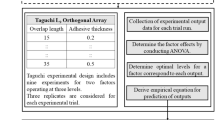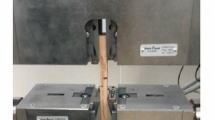Abstract
There are different process parameters of bonding joints in the literature. The main objective of the paper was to investigate the effects of bonding angle, composite lay-up sequences and adherend thickness on failure load of adhesively bonded joints under tensile load. For this aim, the joint has four types of the bonding angles 30°, 45°, 60° and 75°. Composite materials have three different lay-up sequences and various thicknesses. The bonding angle, adherend thickness and composite lay-up sequences lead to an increase of the failure load. Moreover, artificial neural network that utilized Levenberg-Marquardt algorithm model was used to predict failure load of bonding joints. Mean square error was put into account to evaluate productivity of ANN estimation model. Experimental results have been consistent with the predicted results obtained with ANN for training, validation and testing data set at a rate of 0.998, 0.997 and 0.998 respectively.
Similar content being viewed by others
Abbreviations
- E :
-
Young’s modulus (Gpa)
- G :
-
Shear modulus (Gpa)
- υ :
-
Poisson’s ratio (-)
- σ t :
-
Ultimate tensile strength (Mpa)
- θ :
-
Bonding angle (°)
- w :
-
Adherend width (mm)
- t :
-
Adherend thickness (mm)
- a, b :
-
Bonding length (mm)
- L1, L2 :
-
Adherend length (mm)
References
A. J. Kinloch, Adhesives in engineering, Proceedings of the Institution of Mechanical Engineers, Part G: Journal of Aerospace Engineering, 211(5) (1997) 307–335.
M. R. Ayatollahi and A. Akhavan-Safar, Failure load prediction of single lap adhesive joints based on a new linear elastic criterion, Theoretical and Applied Fracture Mechanics, 80(B) (2015) 210–217.
C. Özek and Y. H. Çelik, Calculating molding parameters in plastic injection molds with ANN and developing software, Materials and Manufacturing Processes, 27(2) (2012) 160–168.
G. Zhang, B. Y. E. Patuwo and M. Hu, Forecasting with artificial neural networks, International Journal of Forecasting, 14(1) (1998) 35–62.
E. Tosun and A. Çalık, Failure load prediction of single lap adhesive joints using artificial neural networks, Alexandria Engineering Journal, 55(2) (2016) 1341–1346.
H. E. Balcıoglu, A. C. Seckin and M. Aktas, Failure load prediction of adhesively bonded pultruded composites using artificial neural network, Journal of Composite Materials, 50(23) (2016) 3267–3281.
H. Rangaswamy, I. Sogalad, S. Basavarajappa, S. Acharya and G. Patel, Experimental analysis and prediction of strength of adhesive bonded single lap composite joints: Taguchi and artificial neural network approaches, SN Applied Sciences, 2 (2020) 1055.
J. Neto, R. Campilho and L. da Silva, Parametric study of adhesive joints with composites, International Journal of Adhesion and Adhesives, 37 (2012) 96–101.
L. da Silva, R. Carbas, G. Critchlow, M. Figueiredo and K. Brown, Effect of material, geometry, surface treatment and environment on the shear strength of single lap joints, International Journal of Adhesion & Adhesives, 29(6) (2009) 621–632.
G. Altan and M. Topçu, Experimental and numerical assessment of the improvement of the load-carrying capacities of butterfly-shaped coupling components in composite structures, Journal of Mechanical Science and Technology, 24(6) (2010) 1245–1254.
L. Sun, Y. Tie, Y. Hou, X. Lu and C. Li, Prediction of failure behavior of adhesively bonded CFRP scarf joints using a cohesive zone model, Engineering Fracture Mechanics, 228 (2020) 106897.
S. Matta and M. Ramji, Prediction of mechanical behavior of adhesively bonded CFRP scarf jointed specimen under tensile loading using localised DIC and CZM, International Journal of Adhesion and Adhesives, 89 (2019) 88–108.
C. Wu, C. Chen, L. He and W. Yan, Comparison on damage tolerance of scarf and stepped-lap bonded composite joints under quasi-static loading, Composites Part B, 155 (2018) 19–30.
S. Bardak, S. Tiryaki, T. Bardak and A. Aydin, Predictive performance of artificial neural network and multiple linear regression models in predicting adhesive bonding strength of wood, Strength of Materials, 48(6) (2016) 811–824.
K. Rao, Y. Varadarajan and N. Rajendra, Artificial neural network approach for the prediction of abrasive wear behavior of carbon fabric reinforced epoxy composite, Indian Journal of Engineering and Materials Sciences, 21(1) (2014) 16–22.
X. Qin et al., Delamination analysis of the helical milling of carbon fiber-reinforced plastics by using the artificial neural network model, Journal of Mechanical Science and Technology, 28(2) (2014) 713–719.
M. Amirjan, H. Khorsand, M. H. Siadati and R. Eslami Farsani, Artificial neural network prediction of Cu-Al2O3 composite properties prepared by powder metallurgy method, Journal of Materials Research and Technology, 2(4) (2013) 351–355.
S. Bardak, S. Tiryaki, G. Nemli and A. Aydın, Investigation and neural network prediction of wood bonding quality based on pressing conditions, International Journal of Adhesion and Adhesives, 68 (2016) 115–123.
S. Tiryaki and C. Hamzacebi, Predicting modulus of rupture (MOR) and modulus of elasticity (MOE) of heat treated woods by artificial neural networks, Measurement, 49 (2014) 266–274.
K. S. Kim, Y. M. Yi and G. R. Cho, Failure prediction and strength improvement of uni-directional composite single lap bonded joints, Composite Structure, 82 (2008) 513–520.
M. Y. Tsai and J. Morton, An investigation into the stresses in double-lap adhesive joints with laminated composite adherends, International Journal of Solids and Structures, 47(24) (2010) 3317–3325.
E. S. Mahdi and E. H. Kadi, Crushing behavior of laterally compressed composite elliptical tubes: experiments and predictions using artificial neural networks, Composite Structure, 83 (2008) 399–412.
P. Ramasamy and S. Sampathkumar, Prediction of impact damage tolerance of drop impacted WGFRP composite by artificial neural network using acoustic emission parameters, Composites Part B, 60 (2014) 457–462.
T. Varol, A. Canakci and S. Ozsahin, Artificial neural network modeling to effect of reinforcement properties on the physical and mechanical properties of Al2024-B4C composites produced by powder metallurgy, Composites Part B, 54 (2013) 224–233.
E. M. Bezerra, A. C. Ancelotti and L. C. Pardini, Artificial neural networks applied to epoxy composites reinforced with carbon and E-glass fibers: analysis of the shear mechanical properties, Material Science and Engineering: A, 464(1–2) (2007) 177–185.
J. Dominczuk and J. Kuczmaszewski, Modelling of adhesive joints and predicting their strength with the use of neural networks, Computational Materials Science, 43(1) (2008) 165–170.
M. H. Zgoul, Use of artificial neural networks for modeling rate dependent behavior of adhesive materials, International Journal of Adhesion and Adhesives, 36 (2012) 1–7.
T. Sekercioglu and V. Kovan, Prediction of static shear force and fatigue life of adhesive joints by artificial neural network, Metallic Material, 46(1) (2008) 51–57.
S. Tiryaki and A. Aydın, An artificial neural network model for predicting compression strength of heat treated woods and comparison with a multiple linear regression model, Construction and Building Materials, 62 (2014) 102–108.
R. Kalhor, H. Akbarshahi and S. W. Case, Numerical modeling of the effects of frp thickness and stacking sequence on energy absorption of metal-frp square tubes, Composite Structure, 147 (2016) 231–246.
D. Fernandez, J. Puente and R. Zaera, Prediction of the behavior of cfrps against high-velocity impact of solids employing an artificial neural network methodology, Composites Part A: Applied Science and Manufacturing, 39(6) (2008) 989–996.
A. Turgut and B. Birecikli, The design and mechanical analysis of double zigzag type of adhesive joints, International Journal of Technology and Engineering Studies, 3(5) (2017) 177–183.
T. N. Geleta, K. Woo, D. S. Cairns and D. Samborsky, Failure behavior of inclined thick adhesive joints with manufacturing defect, Journal of Mechanical Science and Technology, 32(5) (2018) 2173–2182.
M. Kumar, J. S. Saini and H. Bhunia, Investigations on the strength of mechanical joints prepared from carbon fiber laminates with addition of carbon nanotubes, Journal of Mechanical Science and Technology, 34(3) (2020) 1059–1070.
L. Amayreh and M. Saka, Failure load prediction of castellated beams using artificial neural networks, Asian Journal Of Civil Engineering (Building And Housing), 6(1–2) (2005) 35–54.
I. Uçkan, T. Yılmaz, E. Hürdoğan and O. Büyükalaca, Development of an artificial neural network model for the prediction of the performance of a silica-gel desiccant wheel, International Journal Of Green Energy, 12(11) (2015) 1159–1168.
Odak Composite Technologies, http://www.odakkompozit.com.tr/en.
ASTM D 3039/D 3039M-00, Standard Test Method for Tensile Properties of Polymer Matrix Composite Materials, American Society for Testing and Materials, Philadelphia, USA (1990).
B. Birecikli, Mechanical analysis of double zigzag type adhesive joints, Ph.D. Thesis, Fırat University Institute of Natural and Applied Sciences, Elazig, Turkey (2016).
D. Sevim, Ş. Fidan, S. Polat and H. Oktay, Experimental and artificial neural network based studies on thermal conductivity of lightweight building materials, European Journal of Technique, 7(1) (2017) 33–41.
Acknowledgments
The authors are obliged to Emin Demir of Odak Composite Corporation, Ankara/Turkey, for manufacturing the samples.
Author information
Authors and Affiliations
Corresponding author
Additional information
Bahadir Birecikli received his Ph.D. from University of Fırat (2016), and is an instructor of Mechanical Engineering in University of Batman. He has done research in the areas of mechanics and composite materials.
Omer Ali Karaman received his Ph.D. from University of Fırat (2018), and is an instructor of Electrical and Electronic Engineering in University of Batman. He has done research in the areas of artificial neural networks.
Selahattin Baris Celebi received his Ph.D. from University of Kirikkale (2020), and is an instructor of Computer Engineering in University of Batman. He has done research in the areas of software and artificial neural networks.
Aydin Turgut received his Ph.D. from University of Fırat (2007), and is a Professor of Mechanical Engineering in University of Bingöl. He has done research in the areas of mechanics and composite materials and finite element analysis.
Rights and permissions
About this article
Cite this article
Birecikli, B., Karaman, Ö.A., Çelebi, S.B. et al. Failure load prediction of adhesively bonded GFRP composite joints using artificial neural networks. J Mech Sci Technol 34, 4631–4640 (2020). https://doi.org/10.1007/s12206-020-1021-7
Received:
Revised:
Accepted:
Published:
Issue Date:
DOI: https://doi.org/10.1007/s12206-020-1021-7




